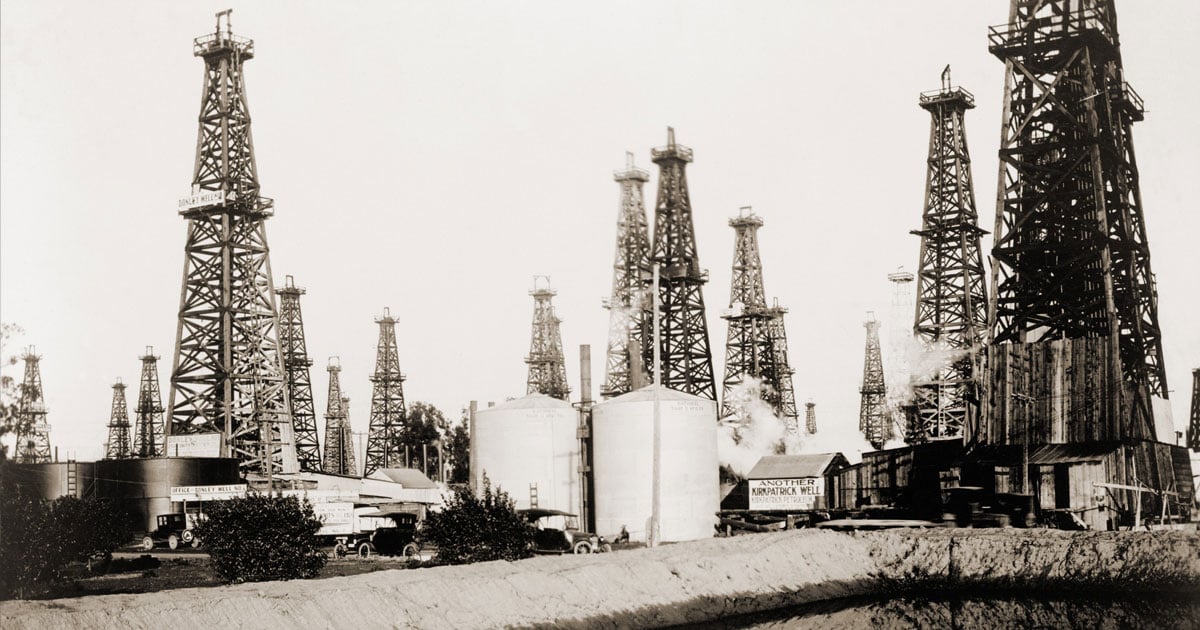
While it has ancient roots, the oil and gas industry has grown exponentially as an integral part of the industrial revolution. In a span of less than two centuries, it has evolved from a small industry focused on heating oil to how we know it today: a massive driver for the global economy.
In this article, we take a look at key events in the history of oil and gas (along with some links for deeper reading).
Throughout its history, oil/gas has been dependent on advancements in key equipment, everywhere from extraction to refining. All of this equipment is expected to perform in extreme operating conditions that include high temperature, high pressure, caustic media, and often 24/7/365 operation.
Early History of Oil and Gas: How did the oil and gas industry get started?
- Petroleum has been used at some scale since early ancient civilizations. These cultures harvested oil from areas where it seeps directly out of the ground. They used the oil for waterproofing, construction, and lighting. The Library of Congress provides more reading resources on ancient oil use here.
- The first known oil well was drilled in China in 347 AD.
- As early as 500 BC, Chinese industry also captured gas using bamboo pipelines. It was then used to boil salt water to extract salt.
- The birth of the modern oil and gas industry is often dated to the pioneering refining experiments conducted by the Scottish chemist James Young in 1847.
Later History of Oil and Gas: What were some of the most important historical events in the oil and gas industry?
James Young began the modern process of discovering new ways of refining petroleum into useful chemical products, including a lighter oil suitable for lamps and a thicker oil for use as a lubricant. Around the same time, Canadian Abraham Gesner discovered Kerosene, which would soon be used to light America at night. The market for lamp oil (where oil-derived fuels largely replaced whale oil) provided the first major lift for the modern, industrial-scale oil and gas industry’s product market.
These early pioneers, however, did not originally work from drilled petroleum, but largely from coal mine seepage and shale-based extraction. These early extraction techniques limited supply, but Polish Chemist Ignacy Łukasiewicz would soon learn to distill lamp oil directly from liquid petroleum that seeped from the ground. By 1859, the first drilled, steam-powered oil well was in operation in the United States. The first oil pipelines were constructed soon thereafter. Early supply limits were alleviated, and the fundamentals of the modern oil and gas industry were in place.
The first commercial use of natural gas occurred in Britain in the 1780s: it was used to light homes and streets. Early gas power was also used for streetlights in Baltimore (1816) and Philadelphia (1836). With these early exceptions (where gas was harvested from nearby wells), natural gas was largely produced as a byproduct of oil drilling. It was often perceived as a dangerous nuisance, and large scale transportation and storage facilities simply weren’t available to make its collection practical. It was usually burned or vented off.
The advent of electricity stunted the market for lamp oil. But, just in time, the advent of the internal combustion engine would soon create a massive new source of demand for oil, a market that has helped sustain massive growth for the oil and gas industry to this day. Over time, oil would also find use in power generation, further increasing demand. Whole new industries, like plastics, would also fuel the demand needed to support the oil and gas industry’s century-long growth spurt.
Meanwhile, natural gas can now be readily captured through extensive pipeline and storage infrastructure. It is now a prime fuel for electrical power generation, providing over 30% of the energy used by the US economy, more than any other fuel source.
Modern Oil and Gas Industry Development Facts
- Important early oil production and refining centers included Baku in Russia, Romania, and the Bradford Oil Field in Pennsylvania, USA (in the 1880s, the Bradford Oil Field accounted for 77% of global oil supply).
- John D. Rockefeller’s Standard Oil famously came to monopolize the early United States oil industry, at one time commanding a market share over 80%. In 1909, Standard Oil would be broken up into 34 different companies in one of the first major anti-trust actions.
- The first “gas station for autoists” opened in St. Louis, Missouri, in 1907.
- The rise of national oil companies and OPEC dramatically reshaped the world oil market starting in the 1960s.
- A major breakthrough in fracking in 1997 would set the stage for a new US oil and gas boom.
Learning More
- You can read about the size and structure of the industry in our oil and gas industry overview blog post here.
- We highlight some recent industry trends here, along with links for further reading on the oil and gas industry’s outlook.
The oil and gas industry has always depended on advancements in technology and equipment. That’s more true today more than ever. From fracking engines, to sea oil rigs, to massive refineries, this industry depends on getting the most possible efficiency out of complex equipment. All of it is expected to thrive in extreme operating environments that include extreme heat, high pressure, and prolonged exposure to corrosive chemicals. Key components are not only needed to perform in these conditions but maintain reliability during extremely long run times (many types of equipment are run 24/7/365).
TriStar’s self-lubricating polymers have proven themselves across a wide variety of oil /gas equipment. For a more focused look at challenges for oil/gas equipment components (and how the right materials can help) click on the button below to see our guide.
TriStar works with many different oil/gas operators and OEM’s to identify solutions to these engineering challenges. Efficiency, safety, and reliability are all essential for oil and gas equipment, which is precisely why material selection matters. We bring a true consultative engineering approach to bear on every client’s business needs, taking the time to understand their business, their equipment, and how smart material selection can maximize ROI for critical components.
If you’d like to talk about your oil/gas equipment component needs, contact our team using the button below.










